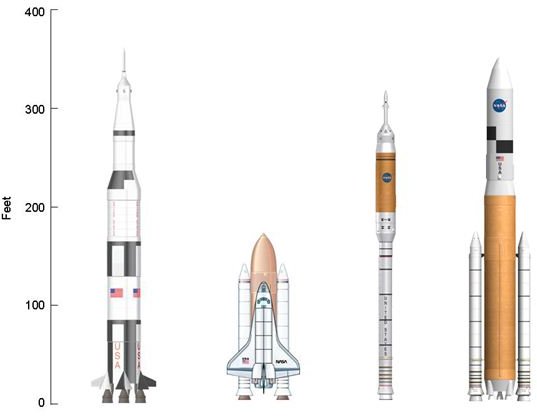Ares vs. Shuttle- A Comparison of Two NASA Space Vehicles
For those who remember watching the first Shuttle launch on April 12, 1981, it may seem as if NASA is taking a step backward in terms of technology with its new Ares rocket and Orion capsule. While the reentry techniques may be totally different, in some ways, the step to Ares makes more sense than the step from Apollo to the Shuttle (formally known as the Space Transportation System). To answer the question of why, though, we need to examine the entire mission profile for both vehicles.
For the launch segment of a mission, we can consider the Ares and Shuttle essentially identical, since both function as rockets during that phase. The Shuttle is more aerodynamically complex due to the interaction between airflows and shockwaves from its various components, and the Ares, carrying its crew at the top and its crew vehicle TPS (thermal protection system) in a protected location, doesn’t have the same vulnerability to debris strikes. Barring those factors, though, the technical challenges posed are extremely similar.
Atmospheric re-entry, though, is an entirely different matter. Both vehicles have to bleed off the majority of their kinetic energy (the Orbiter’s velocity in orbit is on the neighborhood of 17,500 mph, or about five miles a second) through friction with the atmosphere. The heating experienced at any one point is related to the area facing the direction of motion and the shape of the vehicle. A “blunt” vehicle has a lot of area to spread that heat across, while a sharp edge or a point does not. While the Shuttle re-enters nose high to simulate a blunt object, its nose and the leading edge of its wings still experience a far higher temperature than a blunt capsule does, on the order of 2,400 degrees F. Very few materials can handle that temperature, and those that can aren’t very impact resistant. While there are a handful of materials that could potentially handle those temperatures while also serving as major structural members (zirconium diboride and hafnium diboride, high temperature ceramics with melting points in excess of 3000 degrees), these materials have not yet been tested at full scale or under operational conditions. For that reason, capsule re-entry may well be the safer bet for the time being.
The unknown factor lies in the integration of all the components that comprise the Constellation project; even though NASA may have a thorough working knowledge of the parts, unexpected interaction effects may occur. Solving those issues is where the engineers will really earn their pay, and, based on some of the reports of cost overruns and delays in schedule, some of them already seem to have appeared. According to an April 2008 GAO report, the Ares suffers from “unacceptable structural vibrations” in the first stage and complexity issues with the J-2S upper stage motor. To complicate matters even further, the supposedly simpler ablative thermal protection system (TPS) for the crew module may create its own issues, since there are no facilities extant in the US that produce the scale of TPS required. Currently, NASA is attempting to remedy these issues. In some ways, the situation is reminiscent of the X-33; announced in 1996 as a reusable single-stage-to-orbit launch vehicle demonstrator, the X-33 was killed in 2001 due to “technology maturity issues” with its experimental composite liquid hydrogen tank. Only time will tell whether Ares goes the way of the X-33…
Images
Credits
Side-by-side comparison courtesy of NASA
